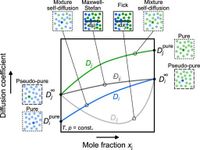A new framework utilizing entropy scaling has emerged as a game-changer for predicting diffusion coefficients within fluid mixtures, addressing longstanding challenges faced by scientists and engineers alike.
The research, conducted by Sebastian Schmitt, H. Hasse, and S. Stephan and published on March 17, 2025, in Nature Communications, introduces this innovative methodology aimed at providing accurate estimates of mixture self-diffusion and mutual diffusion coefficients across various fluid states. This development is especially significant as diffusion plays a pivotal role in numerous natural and technical processes.
Diffusion coefficients are integral for the design of fluid separation processes, reactors, and combustion processes. Nonetheless, obtaining reliable experimental data has proven to be exceptionally difficult, which has necessitated the development of models capable of accurately predicting these properties. Schmitt and his colleagues assert, “The entropy scaling framework predicts mixture diffusion coefficients without adjustable parameters based on pure component and infinite dilution limiting cases.” This approach not only simplifies the modeling process but also enhances the reliability of the predictions.
The proposed entropy scaling framework capitalizes on existing knowledge of self-diffusion coefficients from pure components along with infinite-dilution diffusion coefficients. Through clever application of modified Rosenfeld scaling and Chapman-Enskog theory, the researchers have formulated predictions applicable to the entire fluid region, including gases, liquids, supercritical fluids, and even metastable states.
“The applicability of the model is demonstrated for binary mixtures, and the extension to multi-component systems would be interesting for future work,” the authors note, indicating potential pathways for future research endeavors. This insightful observation highlights the framework's versatility and its capacity to adapt to more complex mixtures.
By treating infinite-dilution diffusion coefficients as pseudo-pure component properties exhibiting monovariate scaling behaviors, the research breaks new ground. It lays the foundation for consistent predictions of both self-diffusion and mutual diffusion coefficients. The framework uniquely combines thermodynamic relationships with sophisticated predictive techniques, representing significant progress toward solving the diffusion coefficient prediction problem.
The study’s findings indicate the model's ability to predict diffusion coefficients without requiring any adjustable mixture parameters. This translational aspect presents tremendous practical relevance for industries reliant on accurate transport properties, such as chemical manufacturing and environmental technology.
Numerical simulations underpinning this work utilized high-performance computing resources to validate the entropy scaling model across various example mixtures. The results displayed impressive alignment between the model’s predictions and existing data, underscoring the reliability of the entropy-based approach.
Within the report, specific examples are provided demonstrating how the predictions hold even for strongly non-ideal mixtures. These findings equip researchers and industry professionals with tools for improved design, modeling, and optimization of processes reliant on precise diffusion characterization.
The insights conveyed through Schmitt and his colleagues’ findings suggest exciting developments on the horizon within the fields of thermodynamics and fluid dynamics. The framework’s integration with established science principles accommodates the exploration of additional fluid behaviors and properties.
Looking forward, the significant rise of computational modeling capabilities opens doors to rapidly advancing research and innovation surrounding mixture diffusion coefficients. The authors advocate for the exploration of multi-component mixtures, presenting the framework not simply as a solution but as the foundation for future breakthroughs.
Schmitt et al. have effectively addressed longstanding challenges, and their work signals transformative potential within the domain of fluid mechanics. This vibrant intersection of theoretical development and practical application is sure to inspire subsequent inquiries, each aimed at peeling back the layers surrounding mixture behaviors and interactions.

